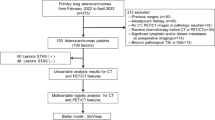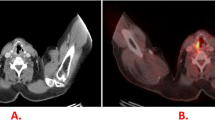Abstract
Purpose
To evaluate the diagnostic performance of 18F-fluorodeoxyglucose (FDG) PET/CT (PET/CT) for determining the presence of pleural metastasis in patients with indeterminate findings on a contrast-enhanced chest CT (CECT) for non-small cell lung cancer (NSCLC).
Materials and methods
This is a retrospective study. NSCLC patients (n = 63) who underwent thoracentesis and/or pleural biopsy were enrolled. CECT and PET/CT reports of pleural metastasis were analyzed based on comparison with cytological or histological confirmation. Negative cytologic results were re-confirmed with follow-up study prior to cancer-related therapy. CECT results were classified into 3 categories: negative, indeterminate, and positive for pleural metastasis. PET/CT results were classified into 2 categories (negative and positive for pleural metastasis) based on FDG uptake visual grading. The level of max SUV of pleura was also analyzed. ROC analysis was done for establishing the max SUV cut-off value.
Result
PET/CT could differentiate pleural metastasis with 70.8% diagnostic accuracy when the CECT finding was indeterminate (n = 24). Optimal cut-off value to predict pleural metastasis was 2.8 for max SUV. Diagnosis by max SUV 2.8 had lower sensitivity (86.3 vs. 92.2%), but higher specificity (66.7 vs. 58.3%) than PET/CT by FDG visual grading criteria.
Conclusion
PET/CT showed better diagnostic performance than CECT for detecting pleural metastasis in NSCLC patients. When the finding of CECT is controversial, PET/CT can differentiate the metastatic pleural lesion. Both FDG uptake visual grading and max SUG cut-off value can be used as diagnostic criteria for pleural metastasis.


Similar content being viewed by others
References
Landis SH, Murray T, Bolden S, Wingo PA. Cancer statistics, 1998. CA Cancer J Clin. 1998;48:6–29.
Gupta NC, Rogers JS, Graeber GM, Gregory JL, Waheed U, Mullet D, et al. Clinical role of F-18 fluorodeoxyglucose positron emission tomography imaging in patients with lung cancer and suspected malignant pleural effusion. Chest. 2002;122:1918–24.
Naruke T, Goya T, Tsuchiya R, Suemasu K. Prognosis and survival in resected lung carcinoma based on the new international staging system. J Thorac Cardiovasc Surg. 1988;96:440–7.
Ishida T, Kohdono S, Hamatake M, Fukuyama Y, Tateishi M, Sugimachi K, et al. Malignant pleurisy and intrathoracic dissemination in carcinoma of the lung: diagnostic, therapeutic and prognostic implications. Int Surg. 1995;80:70–4.
Sawabata N, Matsumura A, Motohiro A, Osaka Y, Gennga K, Fukai S, et al. Malignant minor pleural effusion detected on thoracotomy for patients with non-small cell lung cancer: is tumor resection beneficial for prognosis? Ann Thorac Surg. 2002;73:412–5.
Barrett NR. The pleura: with special reference to fibrothorax. Thorax. 1970;25:515–24.
Muller NL. Imaging of the pleura. Radiology. 1993;186:297–309.
Arenas-Jimenez J, Alonso-Charterina S, Sanchez-Paya J, Fernandez-Latorre F, Gil-Sanchez S, Lloret-Llorens M. Evaluation of CT findings for diagnosis of pleural effusions. Eur Radiol. 2000;10:681–90.
Traill ZC, Davies RJ, Gleeson FV. Thoracic computed tomography in patients with suspected malignant pleural effusions. Clin Radiol. 2001;56:193–6.
Herbert A. Pathogenesis of pleurisy, pleural fibrosis, and mesothelial proliferation. Thorax. 1986;41:176–89.
Leung AN, Muller NL, Miller RR. CT in differential diagnosis of diffuse pleural disease. AJR Am J Roentgenol. 1990;154:487–92.
Abramowitz Y, Simanovsky N, Goldstein MS, Hiller N. Pleural effusion: characterization with CT attenuation values and CT appearance. AJR Am J Roentgenol. 2009;192:618–23.
Kuhlman JE. Complex disease of the pleural space: the 10 questions most frequently asked of the radiologist—new approaches to their answers with CT and MR imaging. Radiographics. 1997;17:1043–50.
Dwamena BA, Sonnad SS, Angobaldo JO, Wahl RL. Metastases from non-small cell lung cancer: mediastinal staging in the 1990s—meta-analytic comparison of PET and CT. Radiology. 1999;213:530–6.
Schaffler GJ, Wolf G, Schoellnast H, Groell R, Maier A, Smolle-Juttner FM, et al. Non-small cell lung cancer: evaluation of pleural abnormalities on CT scans with 18F FDG PET. Radiology. 2004;231:858–65.
Rusch VW, Godwin JD, Shuman WP. The role of computed tomography scanning in the initial assessment and the follow-up of malignant pleural mesothelioma. J Thorac Cardiovasc Surg. 1988;96:171–7.
Menzies R, Charbonneau M. Thoracoscopy for the diagnosis of pleural disease. Ann Intern Med. 1991;114:271–6.
Collins TR, Sahn SA. Thoracocentesis. Clinical value, complications, technical problems, and patient experience. Chest. 1987;91:817–22.
Duysinx B, Nguyen D, Louis R, Cataldo D, Belhocine T, Bartsch P, et al. Evaluation of pleural disease with 18-fluorodeoxyglucose positron emission tomography imaging. Chest. 2004;125:489–93.
Buchmann I, Guhlmann CA, Elsner K, Gfrorer W, Schirrmeister H, Kotzerke J, et al. F-18-FDG PET for primary diagnosis differential diagnosis of pleural processes. Nuklearmedizin. 1999;38:319–22.
Carretta A, Landoni C, Melloni G, Ceresoli GL, Compierchio A, Fazio F, et al. 18-FDG positron emission tomography in the evaluation of malignant pleural diseases—a pilot study. Eur J Cardiothorac Surg. 2000;17:377–83.
Erasmus JJ, McAdams HP, Rossi SE, Goodman PC, Coleman RE, Patz EF. FDG PET of pleural effusions in patients with non-small cell lung cancer. AJR Am J Roentgenol. 2000;175:245–9.
Kramer H, Pieterman RM, Slebos DJ, Timens W, Vaalburg W, Koeter GH, et al. PET for the evaluation of pleural thickening observed on CT. J Nucl Med. 2004;45:995–8.
Toaff JS, Metser U, Gottfried M, Gur O, Deeb ME, Lievshitz G, et al. Differentiation between malignant and benign pleural effusion in patients with extra-pleural primary malignancies: assessment with positron emission tomography-computed tomography. Invest Radiol. 2005;40:204–9.
Benard F, Sterman D, Smith RJ, Kaiser LR, Albelda SM, Alavi A. Metabolic imaging of malignant pleural mesothelioma with fluorodeoxyglucose positron emission tomography. Chest. 1998;114:713–22.
Schneider DB, Clary-Macy C, Challa S, Sasse KC, Merrick SH, Hawkins R, et al. Positron emission tomography with F18-fluorodeoxyglucose in the staging and preoperative evaluation of malignant pleural mesothelioma. J Thorac Cardiovasc Surg. 2000;120:128–33.
Cerfolio RJ, Ojha B, Bryant AS, Raghuveer V, Mountz JM, Bartolucci AA. The accuracy of integrated PET-CT compared with dedicated PET alone for the staging of patients with nonsmall cell lung cancer. Ann Thorac Surg. 2004;78:1017–23.
De Wever W, Ceyssens S, Mortelmans L, Stroobants S, Marchal G, Bogaert J, et al. Additional value of PET-CT in the staging of lung cancer: comparison with CT alone, PET alone and visual correlation of PET and CT. Eur Radiol. 2007;17:23–32.
Hany TF, Steinert HC, Goerres GW, Buck A, von Schulthess GK. PET diagnostic accuracy: improvement with in-line PET-CT system: initial results. Radiology. 2002;225:575–81.
Shim SS, Lee KS, Kim BT, Chung MJ, Lee EJ, Han J, et al. Non-small cell lung cancer: prospective comparison of integrated FDG PET/CT and CT alone for preoperative staging. Radiology. 2005;236:1011–9.
Light RW, Erozan YS, Ball WC Jr. Cells in pleural fluid. Their value in differential diagnosis. Arch Intern Med. 1973;132:854–60.
Light RW. Useful tests on the pleural fluid in the management of patients with pleural effusions. Curr Opin Pulm Med. 1999;5:245–9.
Motherby H, Nadjari B, Friegel P, Kohaus J, Ramp U, Bocking A. Diagnostic accuracy of effusion cytology. Diagn Cytopathol. 1999;20:350–7.
Lewis P, Griffin S, Marsden P, Gee T, Nunan T, Malsey M, et al. Whole-body 18F-fluorodeoxyglucose positron emission tomography in preoperative evaluation of lung cancer. Lancet. 1994;344:1265–6.
Uflacker R, Kaemmerer A, Neves C, Picon PD. Management of massive hemoptysis by bronchial artery embolization. Radiology. 1983;146:627–34.
Lowe VJ, Hoffman JM, DeLong DM, Patz EF, Coleman RE. Semiquantitative and visual analysis of FDG-PET images in pulmonary abnormalities. J Nucl Med. 1994;35:1771–6.
Antoch G, Freudenberg LS, Beyer T, Bockisch A, Debatin JF. To enhance or not to enhance? 18F-FDG and CT contrast agents in dual-modality 18F-FDG PET/CT. J Nucl Med Official Publ Soc Nucl Med. 2004;45(Suppl 1):56S–65S.
Kitajima K, Murakami K, Yamasaki E, Kaji Y, Sugimura K. Accuracy of integrated FDG-PET/contrast-enhanced CT in detecting pelvic and paraaortic lymph node metastasis in patients with uterine cancer. Eur Radiol. 2009;19:1529–36.
Krabbe CA, Balink H, Roodenburg JL, Dol J, de Visscher JG. Performance of (18)F-FDG PET/contrast-enhanced CT in the staging of squamous cell carcinoma of the oral cavity and oropharynx. Int J Oral Maxillofac Surg. 2011;40:1263–70.
Kitajima K, Suzuki K, Senda M, Kita M, Nakamoto Y, Sakamoto S, et al. Preoperative nodal staging of uterine cancer: is contrast-enhanced PET/CT more accurate than non-enhanced PET/CT or enhanced CT alone? Ann Nucl Med. 2011;25:511–9.
Pfannenberg AC, Aschoff P, Brechtel K, Muller M, Bares R, Paulsen F, et al. Low dose non-enhanced CT versus standard dose contrast-enhanced CT in combined PET/CT protocols for staging and therapy planning in non-small cell lung cancer. Eur J Nucl Med Mol Imaging. 2007;34:36–44.
Kitajima K, Murakami K, Yamasaki E, Kaji Y, Shimoda M, Kubota K, et al. Performance of integrated FDG-PET/contrast-enhanced CT in the diagnosis of recurrent pancreatic cancer: comparison with integrated FDG-PET/non-contrast-enhanced CT and enhanced CT. Mol Imaging Biol. 2010;12:452–9.
Dirisamer A, Halpern BS, Flory D, Wolf F, Beheshti M, Mayerhoefer ME, et al. Performance of integrated FDG-PET/contrast-enhanced CT in the staging and restaging of colorectal cancer: comparison with PET and enhanced CT. Eur J Radiol. 2010;73:324–8.
Patz EF Jr, Lowe VJ, Hoffman JM, Paine SS, Burrowes P, Coleman RE, et al. Focal pulmonary abnormalities: evaluation with F-18 fluorodeoxyglucose PET scanning. Radiology. 1993;188:487–90.
Soret M, Bacharach SL, Buvat I. Partial-volume effect in PET tumor imaging. J Nucl Med. 2007;48:932–45.
Conflict of interest
None.
Author information
Authors and Affiliations
Corresponding author
Additional information
M.-Y. Jung and A. Chong equally contributed to the work.
Rights and permissions
About this article
Cite this article
Jung, MY., Chong, A., Seon, H.J. et al. Indeterminate pleural metastasis on contrast-enhanced chest CT in non-small cell lung cancer: improved differential diagnosis with 18F-FDG PET/CT. Ann Nucl Med 26, 327–336 (2012). https://doi.org/10.1007/s12149-012-0575-6
Received:
Accepted:
Published:
Issue Date:
DOI: https://doi.org/10.1007/s12149-012-0575-6




